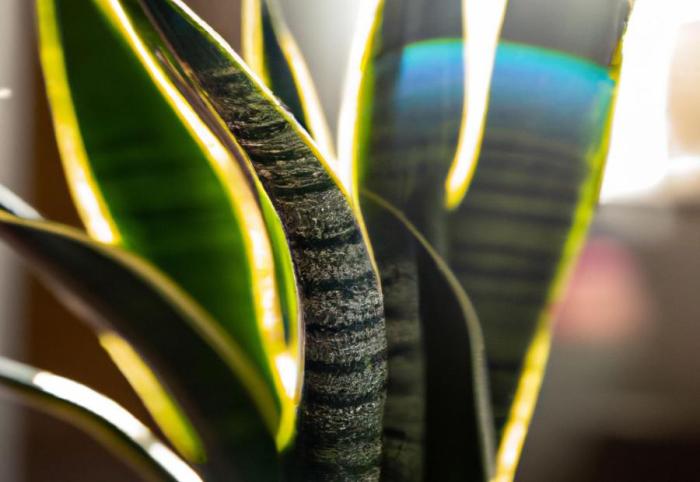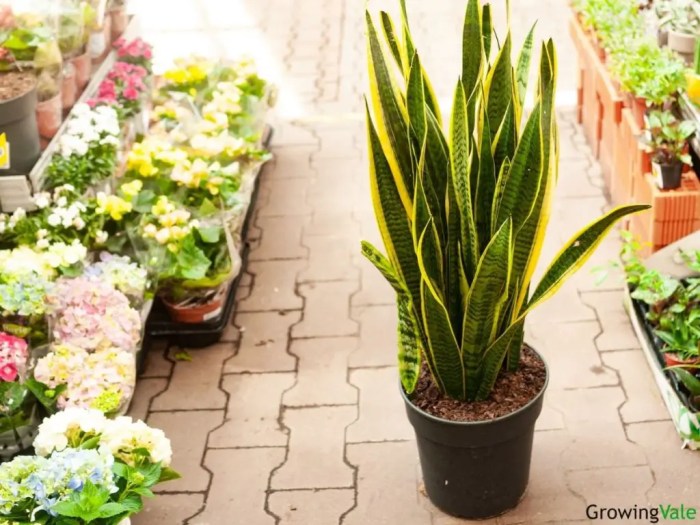How Much to Water a Snake Plant
Understanding Snake Plant Watering Needs
How much to water a snake plant – Proper watering is crucial for the health and longevity of your snake plant. Several factors influence how often you should water, ensuring your plant thrives rather than wilts or rots.
Factors Influencing Watering Frequency
The frequency of watering your snake plant depends on a combination of factors. Understanding these elements is key to preventing both underwatering and overwatering.
- Pot Size: Larger pots retain more moisture, requiring less frequent watering. Smaller pots dry out quicker.
- Soil Type: Well-draining soil is essential. A soil mix that retains too much water increases the risk of root rot. Conversely, very fast-draining soil may dry out too quickly.
- Season: Watering needs change with the seasons. During warmer months (spring and summer), increased evaporation necessitates more frequent watering. In colder months (autumn and winter), watering should be reduced significantly.
- Location: A snake plant in direct sunlight will dry out faster than one in a shady spot. Consider the light exposure when determining your watering schedule.
Signs of Underwatered and Overwatered Snake Plants
Recognizing the signs of both underwatering and overwatering is vital for maintaining a healthy plant.
- Underwatering: Leaves will become limp, soft, and may curl slightly. The soil will be completely dry to the touch.
- Overwatering: Leaves will appear yellow or brown, especially at the base. The soil will be soggy, and you may notice a foul odor. Root rot can occur.
Watering Needs Based on Growing Conditions
The table below summarizes recommended watering frequencies based on various growing conditions.
| Growing Condition | Pot Material | Watering Frequency (Summer) | Watering Frequency (Winter) |
|---|---|---|---|
| Indoor, bright indirect light | Plastic | Every 2-3 weeks | Every 4-6 weeks |
| Indoor, low light | Plastic | Every 3-4 weeks | Every 6-8 weeks |
| Outdoor, partial shade | Terracotta | Every 1-2 weeks | Every 3-4 weeks |
| Outdoor, full sun | Terracotta | Every week | Every 2-3 weeks |
Watering Methods and Techniques
Several methods exist for watering snake plants. Each has its advantages and disadvantages.
Watering Methods Comparison
Choosing the right watering method can significantly impact your snake plant’s health.
- Top Watering: The most common method, involving pouring water directly onto the soil surface. Ensure excess water drains freely.
- Bottom Watering: Placing the pot in a tray of water, allowing the plant to absorb moisture from the bottom up. This method is particularly useful for preventing overwatering.
- Soaking: Thoroughly saturating the soil until water drains from the drainage holes. This method is best used less frequently to deeply hydrate the plant.
Step-by-Step Guide for Top Watering, How much to water a snake plant
- Check the soil moisture. Water only when the top inch or two of soil is dry.
- Use lukewarm water to avoid shocking the plant’s roots.
- Pour water slowly and evenly over the soil surface, ensuring the entire root ball is moistened.
- Allow excess water to drain completely from the drainage holes.
- Empty any collected water in the saucer to prevent root rot.
Soil and Potting Considerations
The right soil and pot are critical for proper drainage and watering.
Importance of Well-Draining Soil

Source: allotinabox.com
Well-draining soil is paramount to prevent root rot. A mix that retains too much water will suffocate the roots, leading to plant decline.
Role of Pot Size and Material
Pot size and material affect how quickly the soil dries. Larger pots retain moisture longer, while terracotta pots dry out faster than plastic pots due to their porous nature.
Ideal Soil Compositions for Snake Plants
A well-draining soil mix is crucial for healthy snake plant growth. The table below shows examples of suitable soil compositions.
| Component | Percentage | Function | Notes |
|---|---|---|---|
| Potting Mix | 50% | Provides essential nutrients | Use a well-draining mix |
| Perlite | 25% | Improves drainage and aeration | Avoid using too much perlite |
| Coarse Sand | 25% | Enhances drainage | Use horticultural sand, not beach sand |
Seasonal Watering Adjustments
Watering frequency should be adjusted according to seasonal changes in temperature and humidity.
Proper watering is key for a thriving snake plant; generally, allowing the soil to dry out completely between waterings is best. This contrasts with the propagation method often used for spider plants, where you might wonder, “can spider plants live in water?” Indeed, finding the answer to that question on can spider plants live in water is helpful.
Returning to snake plants, infrequent, thorough watering prevents root rot and ensures healthy growth.
Watering Frequency by Season
The following provides general guidelines. Adjust based on your specific climate and growing conditions.
- Spring: Gradually increase watering frequency as temperatures rise.
- Summer: Water more frequently due to increased evaporation and higher temperatures.
- Autumn: Reduce watering as temperatures cool and days shorten.
- Winter: Water sparingly, only when the soil is completely dry.
Watering Schedules for Various Climates
Arid climates will require less frequent watering than humid climates. Observe your plant’s condition and adjust accordingly.
- Arid Climates: Water less frequently; allow the soil to dry out completely between waterings.
- Humid Climates: Water more frequently, but still ensure good drainage to prevent root rot.
Troubleshooting Watering Issues
Improper watering can lead to several problems. Early detection and intervention are crucial.
Common Problems and Solutions
- Root Rot: Soggy soil, yellowing leaves, foul odor. Repot in fresh, well-draining soil, removing any affected roots.
- Leaf Discoloration: Yellowing or browning leaves can indicate both overwatering and underwatering. Adjust watering frequency based on soil moisture and leaf condition.
- Wilting: Limp leaves usually indicate underwatering. Water thoroughly and monitor the plant’s recovery.
Troubleshooting Guide
- Symptom: Yellowing leaves, mushy stems. Solution: Reduce watering frequency; check for root rot.
- Symptom: Brown leaf tips, dry soil. Solution: Water more deeply and frequently.
- Symptom: Limp, droopy leaves. Solution: Water thoroughly and allow excess water to drain.
Visual Guide to Watering
This section describes the appearance of a properly watered snake plant compared to underwatered and overwatered ones.
Properly Watered Snake Plant
The leaves are firm, upright, and a vibrant green color. The soil is moist but not soggy, feeling slightly damp to the touch. The plant exhibits strong, healthy growth.
Underwatered Snake Plant
The leaves are limp, soft, and may appear slightly curled. The soil is completely dry and crumbly. The plant may show signs of stunted growth.
Overwatered Snake Plant
The leaves are yellow or brown, especially at the base. The soil is soggy and may have a foul odor. The plant may exhibit signs of root rot, with soft, mushy roots.
Healthy vs. Unhealthy Roots

Source: growingvale.com
Healthy roots are firm, white, or light-colored. Unhealthy roots are brown, mushy, and may have a foul odor. Healthy roots have a robust, fibrous appearance, while unhealthy roots are often slimy and disintegrating.
FAQ Insights: How Much To Water A Snake Plant
Can I use tap water to water my snake plant?
It’s best to use filtered or room temperature water to avoid introducing chlorine or fluoride, which can harm the plant.
How often should I check the soil moisture?
Check the soil moisture at least once a week, especially during the growing season. Stick your finger a couple of inches into the soil; if it’s dry, it’s time to water.
What are the signs of root rot?
Signs of root rot include mushy, dark brown or black roots, yellowing leaves, and a foul odor from the soil.
My snake plant leaves are drooping. Is it underwatered or overwatered?
Drooping leaves can indicate both underwatering and overwatering. Check the soil moisture; if it’s bone dry, it’s likely underwatered. If it’s soggy, it’s likely overwatered.
Can I propagate my snake plant from cuttings?
Yes, snake plants are easily propagated from leaf cuttings or stem cuttings. Ensure the cuttings are allowed to callous before planting.




















